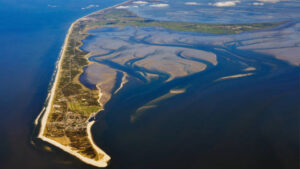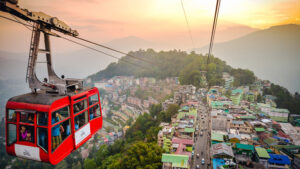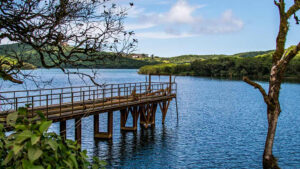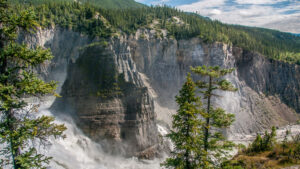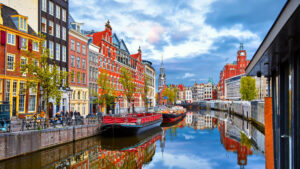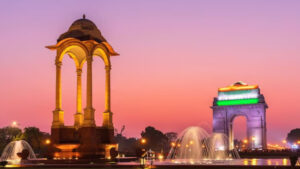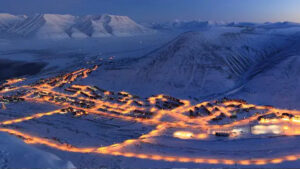THE JAISALMER FORT – ENJOY ROYAL SPLENDOUR AND ENCHANTING HERITAGE

The Jaisalmer Fort, located in the heart of Jaisalmer city in Rajasthan, India, is a magnificent UNESCO World Heritage Site and one of the largest fully preserved fortified cities in the world. Perched atop the Trikuta Hill, the fort stands as a testament to the rich history and architectural splendor of Rajasthan.

Built-in 1156 AD by Rajput ruler Rawal Jaisal, the Jaisalmer Fort is made of yellow sandstone, giving it a mesmerizing golden hue that beautifully reflects the sunlight. It is often referred to as the “Golden Fort” or “Sonar Qila” due to its distinctive appearance.
The fort’s architectural grandeur includes impressive bastions, towering gateways, and ornate balconies. The intricate stone carvings, jharokhas (balconies), and filigree work showcase the skilled craftsmanship of Rajasthani artisans. From the fort’s ramparts, you can enjoy panoramic views of the surrounding Thar Desert, with its endless stretches of golden sands and picturesque sunsets.
Additionally, the fort’s narrow lanes are lined with vibrant shops, bustling bazaars, and traditional eateries where you can shop for handicrafts, textiles, jewelry, and savor local Rajasthani cuisine.
Inside the Fort
Inside the majestic Jaisalmer Fort, you’ll discover a world of fascinating attractions and experiences that showcase the rich heritage and cultural treasures of Rajasthan. Here are some highlights of what awaits you inside the fort:
- Jain Temples: The Jaisalmer Fort is home to a cluster of exquisitely carved Jain temples, known for their intricate architecture and detailed sculptures. These temples, dedicated to different Jain Tirthankaras (spiritual teachers), are adorned with ornate pillars, frescoes, and finely carved marble and sandstone designs.
- Raj Mahal (Royal Palace): Explore the grandeur of the Raj Mahal, the main palace inside the fort. Admire its beautifully carved balconies, ornamental arches, and intricately painted ceilings. The palace houses a museum where you can view a collection of royal artifacts, including weaponry, textiles, and artworks.
- Jawahar Palace: Another notable palace within the fort, Jawahar Palace showcases a unique blend of Rajput and Islamic architectural styles. While the palace is not open to the public as it is privately owned, you can still marvel at its stunning façade from the outside.
- Havelis (Mansions): Wander through the narrow lanes of the fort and encounter magnificent havelis that exemplify the opulence of the bygone era. Patwon Ki Haveli, Nathmal Ki Haveli, and Salim Singh Ki Haveli are among the prominent ones, each displaying exquisite stone carvings, elaborate facades, and intricate detailing.
- Lively Markets: The bustling streets inside the fort are dotted with colorful shops and bustling markets. Explore the vibrant bazaars and browse through a variety of handicrafts, textiles, jewelry, and local artifacts. Don’t forget to bargain for the best deals and take home souvenirs of your Jaisalmer experience.

- Rooftop Cafes and Restaurants: Ascend to the fort’s rooftop cafes and restaurants to enjoy breathtaking views of the surrounding city, desert, and sunset. Indulge in traditional Rajasthani cuisine, including mouthwatering daal baati churma, gatte ki sabzi, and deliciously spiced kebabs.
Interesting Facts
Here are some interesting facts about the Jaisalmer Fort:
- Architecture: The Jaisalmer Fort is a prime example of Rajput military architecture. It was built using yellow sandstone, which gives the fort its distinctive golden color. The fort’s walls are about 30 feet high and have a circumference of approximately 1.5 kilometers.
- Living Fort: Unlike many other forts in India, the Jaisalmer Fort is a living fort with a significant population residing within its walls. It is estimated that around 3,000 people still live in the fort, including merchants, craftsmen, and families who have been living there for generations.
- UNESCO World Heritage Site: The Jaisalmer Fort was designated as a UNESCO World Heritage Site in 2013, recognizing its cultural significance and outstanding universal value. It is considered one of the best-preserved fortified cities in the world.
- Water Conservation: The fort has a unique and innovative water conservation system. It has several underground tanks and reservoirs that were designed to store rainwater. These reservoirs were strategically placed to collect and store water for the fort’s residents during times of scarcity.
- Architectural Marvels: Inside the fort, you’ll find intricately carved havelis (mansions) that display remarkable craftsmanship. The fine stone carvings, jharokhas (balconies), and ornate facades are a testament to the artistic skills of the artisans of that era.
- Sonar Kella: The Jaisalmer Fort gained global recognition after being featured in the acclaimed film “Sonar Kella” (The Golden Fortress), directed by the renowned filmmaker Satyajit Ray. The film showcased the fort’s majestic beauty and contributed to its popularity among travelers.
- Cultural Events: The Jaisalmer Fort serves as a vibrant cultural hub, hosting various events and festivals throughout the year. The Rajasthan International Folk Festival (RIFF) is one of the notable events held within the fort, featuring live music performances, dance, and traditional Rajasthani arts.
Top Attractions Nearby
Jaisalmer, the city where the Jaisalmer Fort is located, offers several other notable attractions nearby. Here are some top attractions you can explore during your visit:

- Sam Sand Dunes: Located about 40 kilometers from Jaisalmer, the Sam Sand Dunes are a popular tourist destination, especially for those seeking the quintessential desert experience. Enjoy a camel ride, witness mesmerizing sunsets, and indulge in traditional Rajasthani cultural performances amidst the golden sand dunes.
- Patwon Ki Haveli: Visit Patwon Ki Haveli, a cluster of five intricately carved havelis located in the heart of Jaisalmer. Admire the architectural brilliance and fine craftsmanship displayed in these historic mansions, which were once inhabited by wealthy merchants.
- Bada Bagh: Explore Bada Bagh, a tranquil garden complex located about 6 kilometers from Jaisalmer. It is adorned with royal cenotaphs (chhatris) dedicated to the rulers of the Bhatti dynasty. The complex offers stunning views of the surrounding desert landscape.
- Desert National Park: For nature enthusiasts, a visit to the Desert National Park is highly recommended. Located about 45 kilometers from Jaisalmer, this park is home to a variety of desert wildlife, including migratory birds, blackbuck, and desert foxes. Take a jeep safari or a guided nature walk to explore the unique ecosystem of the Thar Desert.
- Gadisar Lake: Enjoy the serene beauty of Gadisar Lake, a man-made reservoir located in Jaisalmer. Take a boat ride, relax by the lakeside, and soak in the tranquility of this picturesque spot. The lake is also surrounded by several temples and cenotaphs, adding to its cultural significance.
- Kuldhara Village: Embark on a journey to Kuldhara, an abandoned village located around 20 kilometers from Jaisalmer. The village is known for its intriguing history and folklore. Explore the deserted streets, learn about its mysterious past, and marvel at the architectural remnants of this once-thriving community.
Shopping and Must Try Cuisine
Shopping in Jaisalmer offers a delightful experience with a variety of unique handicrafts and textiles. Here are some popular shopping items you can find in the city:
- Handmade Textiles: Jaisalmer is known for its exquisite textiles, including embroidered fabrics, block-printed textiles, and tie-dye fabrics. Look for traditional Rajasthani garments such as bandhani (tie-dye) sarees, vibrant turbans, and embroidered jackets.
- Camel Leather Goods: Jaisalmer is famous for its camel leather products. You can find a wide range of items such as bags, wallets, belts, footwear, and intricately designed journals. The craftsmanship and quality of these leather goods make them a popular choice among visitors.
- Silver Jewelry: Explore the vibrant jewelry shops in Jaisalmer and discover beautiful silver jewelry adorned with intricate designs and semi-precious stones. From earrings and necklaces to bracelets and anklets, you’ll find an array of traditional and contemporary pieces to suit your taste.
- Rajasthani Handicrafts: Jaisalmer is a treasure trove of Rajasthani handicrafts. Look for wooden artifacts, pottery, hand-painted ceramics, miniature paintings, puppets, and marble carvings. These exquisite pieces make for unique souvenirs and home decor items.
When it comes to cuisine, Jaisalmer offers a delightful culinary experience. Here are some must-try dishes:
- Dal Baati Churma: This iconic Rajasthani dish consists of baked dough balls (baati) served with lentil curry (dal) and a sweet crumbled wheat dessert (churma). It is a rich and flavorful combination that is a must-try for food enthusiasts.
- Laal Maas: A fiery meat curry made with succulent pieces of mutton or lamb, Laal Maas is a specialty of Rajasthan. The dish gets its vibrant red color and spiciness from the use of fiery red chilies and a blend of aromatic spices.
- Ker Sangri: A traditional Rajasthani dish, Ker Sangri is a unique combination of dried berries (ker) and beans (sangri) cooked with spices. It is often served as a side dish with Indian bread (roti) or rice.
- Gatte ki Sabzi: This Rajasthani specialty features gram flour dumplings cooked in a spicy yogurt-based gravy. It is a comforting and flavorful vegetarian dish that pairs well with steamed rice or roti.
- Kachori: Jaisalmer is known for its delicious kachoris, which are deep-fried flaky pastries filled with a spicy lentil or potato mixture. These crispy and savory snacks are perfect for a quick bite.
- Mawa Kachori: A sweet variation of the traditional kachori, Mawa Kachori is a rich dessert made with a sweetened khoya (mawa) filling, deep-fried to perfection, and garnished with sugar syrup and nuts.

Best Time to Visit
The best time to visit Jaisalmer is during the winter months, from October to March. This period offers pleasant weather with cool mornings, warm days, and chilly evenings, making it ideal for exploring the city’s attractions and engaging in outdoor activities.
Visiting Jaisalmer during winter allows you to avoid the scorching heat of the summer months when temperatures can soar above 40°C (104°F) and make outdoor activities uncomfortable. Winter also coincides with the festive season in Rajasthan, with celebrations like Diwali and Desert Festival adding to the cultural vibrancy of the city.
While winter is the best time to visit Jaisalmer, it’s worth mentioning that the city is accessible and open to tourists throughout the year. If you don’t mind the hot weather, visiting during the shoulder seasons of spring (March to April) and autumn (September to October) can also be pleasant, with fewer crowds and lower prices.






